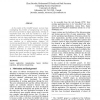Free Online Productivity Tools
i2Speak
i2Symbol
i2OCR
iTex2Img
iWeb2Print
iWeb2Shot
i2Type
iPdf2Split
iPdf2Merge
i2Bopomofo
i2Arabic
i2Style
i2Image
i2PDF
iLatex2Rtf
Sci2ools
ICSM
2002
IEEE
2002
IEEE
From Legacy to Web through Interaction Modeling
In the context of the CelLEST project, we have been investigating the problem of reengineering and reusing the services provided by legacy applications, running on mainframe hosts. This work has resulted in a suite of methods, based on understanding and modeling the users’ interaction with the legacy-application interface. These methods aim at (a) modeling the behavior of the legacy user interface as a state-transition diagram, (b) recovering specifications for the application’s functions by discovering the users’ tasks as frequently occurring interaction patterns, and (c) constructing new userinterface front-ends to make the recovered legacy functions accessible through the Web. In this paper, we describe the overall process for legacy migration to the World Wide Web, using the CelLEST methods, and we illustrate it with an example case study. Keywords Legacy application reengineering, legacy interface migration, interaction reengineering.
ICSM 2002 | Legacy Application | Legacy Interface Migration | Legacy User Interface | Software Engineering |
| Added | 15 Jul 2010 |
| Updated | 15 Jul 2010 |
| Type | Conference |
| Year | 2002 |
| Where | ICSM |
| Authors | Eleni Stroulia, Mohammad El-Ramly, Paul G. Sorenson |
Comments (0)

